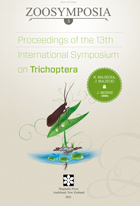Abstract
The aim of the study, carried out in a section of the Drzewiczka River downstream of a dam reservoir and a white-water canoeing track, was to estimate seasonal changes in the number of drifting invertebrates, especially Trichoptera and their body size and weight as compared with individuals living in benthos. It was also important to determine environmental factors which have the most significant influence on transported invertebrate fauna.
The abundance of Trichoptera in benthos and drift was estimated for stonegravel habitats at 2 study sites; one just downstream of a canoeing track, which underwent flow fluctuations, marked as disturbed (D), and the other, control site (N), 10 km farther downstream, where no changes caused by 2 hydro-constructions were noticed.
The percentage of dominant Trichoptera in drift [U coefficient, %] ranged from 0.0001 (Hydropsyche contubernalis McLachlan) to 0.06 (Halesus sp.). The U value for Trichoptera was 0.0005 and 0.012 at the 2 study sites, respectively, which indicates that when there was no correlation with the flow/current velocity, drifting preferences of Trichoptera were random or dependent on seasons, seasonal reservoir management, and larval concentration in the benthos, and at the same time independent of canoeist training. The highest number of drifting individuals was observed between March/April and August/September. This might be connected with a release of a larger amount of water from the impoundment after spring thaw and autumn rain, especially because sudden increases in water level and current velocity were noticed at that time.
The increase in abundance of early developmental stages (juvenile) of caddis larvae in drift took place mainly in autumn and winter, whereas larvae at more advanced developmental stages were more frequently noticed in late spring. The differences in Trichopteran sizes at their 3th, 4th and 5th larval instars representing benthos and drift were observed by comparing the width of the head capsule [mm] and body mass [mg] of the examined individuals. Organisms transported in running water were definitely smaller than benthic ones, with the exception of the most developed larvae of H. pellucidula (Curtis).

